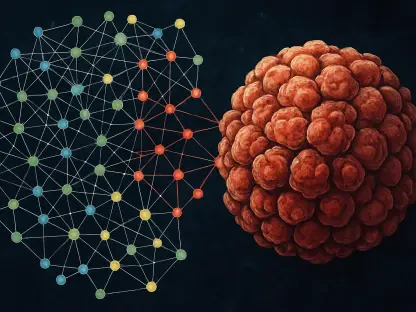Ivan Kairatov, a highly respected expert in the Biopharma industry, delves into the groundbreaking findings surrounding PPP2R1A mutations in ovarian clear cell carcinoma (OCCC) and their implications for cancer treatment. With his deep understanding of biotechnology and innovation, Kairatov shares insights on how these discoveries could reshape therapeutic strategies in oncology.
Can you explain the role of PPP2R1A mutations in ovarian clear cell carcinoma and how they contribute to improved survival rates following immunotherapy?
The presence of PPP2R1A mutations in ovarian clear cell carcinoma seems to have a significant impact on tumor biology that makes them more responsive to immunotherapy. These mutations appear to modify the immune environment within the tumor in a way that enhances the effectiveness of immune checkpoint inhibitors, leading to a remarkable improvement in survival rates. Specifically, patients with these mutations experienced a median overall survival extending beyond five years post-treatment, which is a substantial increase compared to those without the mutations.
What is the significance of finding PPP2R1A mutations as a potential biomarker for guiding treatment in OCCC?
Identifying PPP2R1A mutations as a biomarker is crucial because it provides a targeted approach to treatment, allowing us to identify patients who are more likely to benefit from immunotherapy. This helps personalize treatment plans, ensuring that patients receive therapies most likely to be effective for them, thereby potentially avoiding the unnecessary side effects of treatments that might not be beneficial.
Could you describe the Phase II trial that was conducted and what the main findings were?
The Phase II trial explored the outcomes of 34 patients with treatment-resistant OCCC treated with a combination of immune checkpoint inhibitors, durvalumab and tremelimumab. The key finding was that those with PPP2R1A mutations showed a notably prolonged median overall survival compared to those without such mutations. This trial not only confirmed the significance of these mutations in enhancing survival but also extended the analysis to other cancer types, indicating a broader potential applicability of this biomarker.
How did outcomes vary between patients with PPP2R1A mutations and those without them in the trial?
Patients with PPP2R1A mutations had a median overall survival of 66.9 months, which was significantly longer than the 9.2 months observed in patients without these mutations. This stark contrast highlights the mutation’s potential as a predictive biomarker for successful immunotherapy in OCCC.
What is the potential impact of these findings on developing new treatment strategies for ovarian cancer and other cancer types?
These findings could revolutionize treatment strategies by providing a new therapeutic target in PPP2R1A and PP2A pathways. For ovarian cancer, and possibly other cancer types, therapies that target these pathways could be developed to enhance the efficacy of existing immunotherapies or even create new treatment paradigms altogether.
Can you elaborate on how targeting the PPP2A molecular pathway might boost immunotherapy outcomes?
Targeting the PPP2A molecular pathway, which is linked to PPP2R1A mutations, could potentially enhance the immune response against cancer cells. By affecting this pathway, we might be able to make tumor cells more visible or susceptible to the immune system, thus improving the response to immunotherapy, leading to better survival outcomes.
What challenges do you foresee in translating these findings into practical clinical applications?
One major challenge is the relative rarity of PPP2R1A mutations, which might limit the initial pool of patients who can benefit. Additionally, developing therapies targeting the PPP2A pathway could be complex, requiring significant investment in research and clinical trials to ensure safety and efficacy.
Are there specific drugs being tested to target the PPP2A pathway? If so, what is their current development status?
Currently, there are clinical trials underway at institutions like MD Anderson evaluating drugs that target the PPP2A pathway. These studies are still in relatively early stages, focusing on assessing the safety and preliminary efficacy of these new therapeutic approaches.
How might the identification of PPP2R1A mutations influence the direction of future research efforts in this field?
The discovery of PPP2R1A mutations as a powerful biomarker will likely pave the way for more research focused on understanding the underlying mechanisms and exploring additional pathways that could be targeted. This could expand our options for patient-specific cancer therapies and lead to new, more effective drugs.
What collaborative efforts contributed to this study, and who were the key participants in the research?
The study was a collaborative effort involving various experts across disciplines. Led by noted individuals from MD Anderson and the James P. Allison Institute, it included contributions from genomics, experimental therapeutics, and clinical research specialists, highlighting a team effort in unraveling the potential of PPP2R1A mutations.
How did the laboratory research support the clinical findings, suggesting a causal link to PPP2R1A targeting?
Laboratory assays both in vitro and in vivo provided crucial evidence showing that targeting PPP2R1A improved immunotherapy responses. These experiments confirmed the important role of the PP2A pathway in modifying the tumor environment, thus supporting the clinical outcomes observed in patients.
Were there any unexpected results or findings that emerged during the study?
One unexpected finding was the broader applicability of PPP2R1A mutations beyond ovarian cancer, as the analysis included patients with endometrial and other cancers, showing similar survival benefits following immunotherapy. This suggests that pathways involving PPP2R1A could be influential across different cancer types.
Considering that PPP2R1A mutations are relatively uncommon, how significant is this discovery in terms of broader implications?
Despite their rarity, the discovery of PPP2R1A mutations is significant because it highlights a specific genetic alteration that can be leveraged for highly effective treatment. This sets a precedent for looking at other rare mutations with the potential to profoundly impact cancer therapy protocols.
How was the study funded, and what role did the supporting organizations play in facilitating the research?
This research was supported by numerous prestigious bodies, including the NIH, National Cancer Institute, and DOD, among others. These organizations provided the necessary financial backing and resources required to conduct such a comprehensive and multidisciplinary study, from laboratory experiments to clinical trials.
What future studies are planned to further explore the role of PPP2R1A mutations and the PPP2A pathway in cancer treatment?
Future studies aim to delve deeper into the mechanisms by which PPP2R1A mutations enhance immunotherapy responses and expand the research to other cancers where this pathway might play a critical role. Additionally, ongoing trials will continue to evaluate drugs targeting the PPP2A pathway to refine these findings into clinically applicable treatments.









